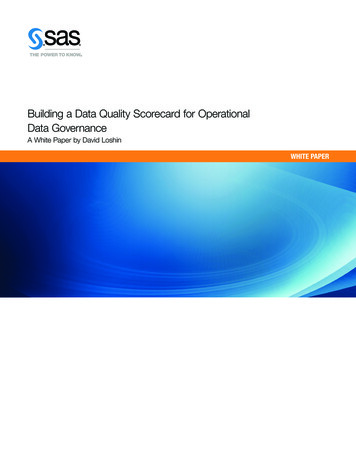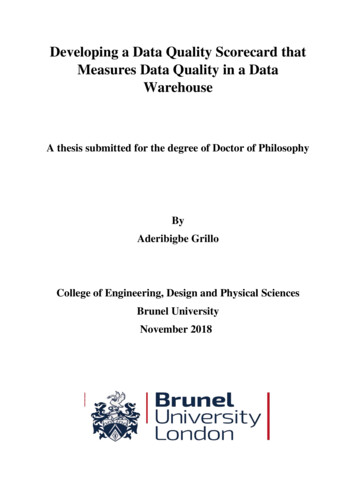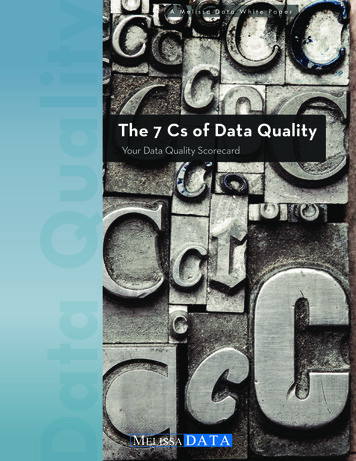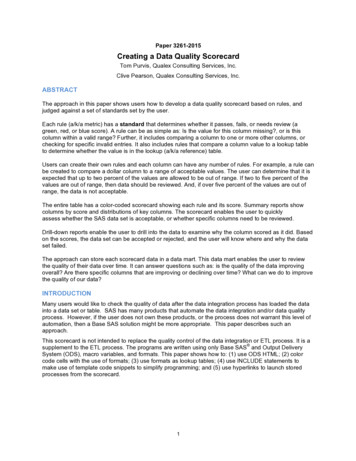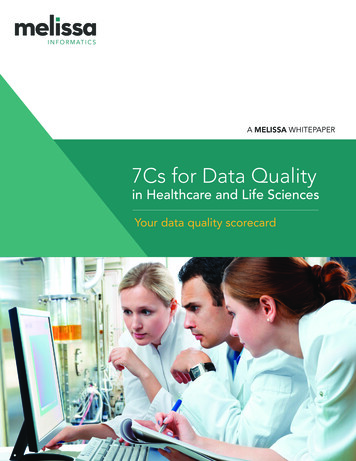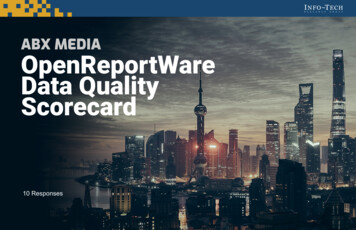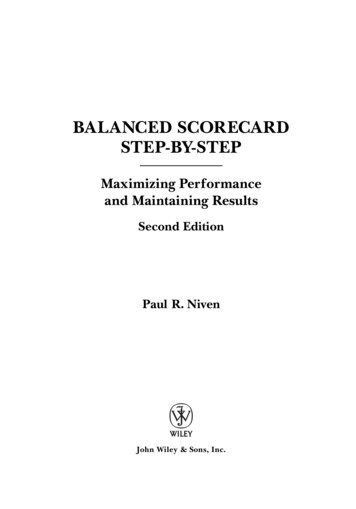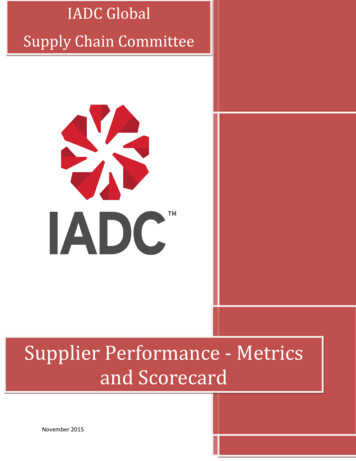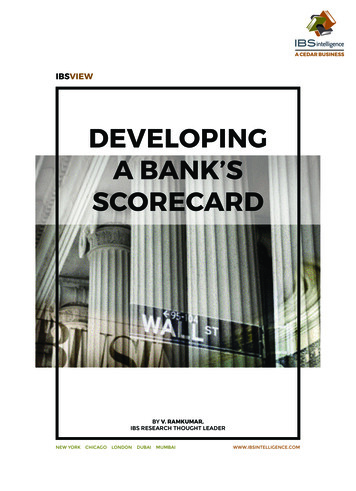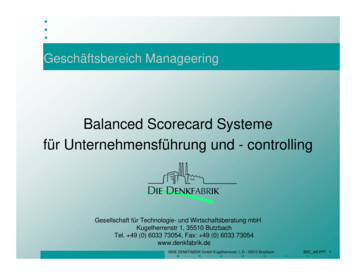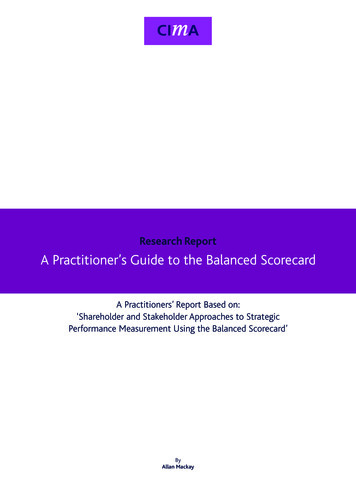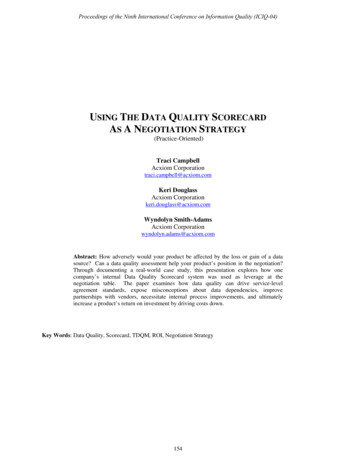
Transcription
Proceedings of the Ninth International Conference on Information Quality (ICIQ-04)USING THE DATA QUALITY SCORECARDAS A NEGOTIATION STRATEGY(Practice-Oriented)Traci CampbellAcxiom Corporationtraci.campbell@acxiom.comKeri DouglassAcxiom Corporationkeri.douglass@acxiom.comWyndolyn Smith-AdamsAcxiom Corporationwyndolyn.adams@acxiom.comAbstract: How adversely would your product be affected by the loss or gain of a datasource? Can a data quality assessment help your product’s position in the negotiation?Through documenting a real-world case study, this presentation explores how onecompany’s internal Data Quality Scorecard system was used as leverage at thenegotiation table. The paper examines how data quality can drive service-levelagreement standards, expose misconceptions about data dependencies, improvepartnerships with vendors, necessitate internal process improvements, and ultimatelyincrease a product’s return on investment by driving costs down.Key Words: Data Quality, Scorecard, TDQM, ROI, Negotiation Strategy154
Proceedings of the Ninth International Conference on Information Quality (ICIQ-04)BACKGROUNDThroughout 2003 and 2004, Acxiom Corporation challenged itself to answer the question, “How’s YourData Quality?” As a result, this data integration organization innovated a corporate-wide data qualitystrategy called the Data Quality Scorecard (DQS); this unique system was based on Total Data QualityManagement (TDQM) principles, implemented across multiple data products, and viewed as leverage forAcxiom’s competitive advantage in the marketplace [1].In the case study that follows, the authors examine how they were able to further the impact of the DataQuality Scorecard strategy by considering the return on investment (ROI) benefits of conducting such ananalysis. In this real-world example, Acxiom exhibits a data dependency analysis (conducted using theData Quality Scorecard approach) as a repeatable TDQM model used to assess data providers in a multisourced data repository; we identify where and when to take corrective action to improve data quality andprioritize the areas that can be a “deal maker” or “deal breaker” with data providers; and we discuss howa Data Quality Scorecard analysis can provide leverage at the negotiation table.OVERVIEW OF THE PROBLEMOur corporate-wide data quality strategy helps solve the challenge of measuring data quality for multipleinformation products within an organization. The DQS provides the framework for data products toconsistently benchmark, measure, trend, analyze, and improve data quality at various touch points withina “data factory.”CORPORATETDQM PROGRAMMARKETINGCORRECTIVE ACTIONDATA SUPPLIERS(RAW DATA)PRODUCTSDATA D DATASERVICESFigure 1: Corporate Data Quality System. This diagram represents the interaction of theTDQM system with the corporation’s data factory. Solid lines represent the flow ofcommunication and product quality requirements; dotted lines represent communication of andparticipation in the Corporate TDQM Program. Data quality measurements flow horizontallyfrom “Data Suppliers” to “Data Repository” to “Product”, which is where the focus of this casestudy lies.155
Proceedings of the Ninth International Conference on Information Quality (ICIQ-04)The shaded area in Figure 1 represents the flow of data leading horizontally across the factory into dataproducts. Raw data feeds into a “data repository” from which different data products extract what theircustomers need. If a particular data product is “multi-sourced”, some of the raw data may be purchasedfrom an external vendor and some may be compiled internally.When our corporation first developed the DQS, we challenged ourselves to answer one simple question:“How’s your Data Quality?”. Once we gained control over our internal products, we began asking, “Howdoes the quality of our data providers impact our product?”, “How adversely would our products beaffected by the loss or gain of a data source?”, and “How can we use Data Quality in negotiations withour data suppliers?” This case study explores how we were able to answer those questions for one of ourdata products.CASE STUDY: CONSUMER PHONE PRODUCTOur organization builds a number of consumer data products, one of which is a telephone data product.For purposes of this study, we refer to this product as “Product A.” Product A is a multi-sourced product— raw telephone data is compiled from internal sources, and raw data is purchased from externaltelephone data suppliers. Multiple data sources are combined to build Product A:Source XDATAPRODUCT“A”Source YSource ZFigure 2: Multi-sourced Data Product “A”.Product A employs a corporate-wide DQS system and understands their data quality position in themarketplace. However, data sources are typically stable during assessment periods.At contract renewal time, “Source X” decided to cancel their contract with Product A, meaning theywould no longer supply data to the product. Source X was Product A’s largest data contributor, the mostcostly, and presumably generated the highest quality data.Analysis ApproachProduct A’s dependency on Source X was significant, but not fully quantified. Product A’s companyneeded to assess the internal impact of losing their largest data provider. The product had high, perceivedconfidence in Source X and was convinced it needed to replace the source in order to maintain its dataquality position in the marketplace and potentially improve ROI.Without access to sample data from Source X, it was not feasible to conduct an internal data qualityassessment to quantify the confidence. Even if data quality statistics from Source X were available, itwould be difficult to quantify the impact on Product A after integrating additional sources. Ourapproach— rather than “quantify the loss” of Source X— was to evaluate the quality of Product A afterintegration with and without Source X and quantify the gap. This data quality gap could ultimately beused in negotiating a new contract with Source X.In addition, to fully determine our organization’s dependence on Source X, we knew we needed toexamine the quality of “Product A without Source X” in the marketplace. While the DQS “meta-metrics”demonstrate how closely aligned Product A is to its data quality goals, Product A’s essential concern washow the loss of Source X would affect its market position.156
Proceedings of the Ninth International Conference on Information Quality (ICIQ-04)Data Dependency AnalysisIn our data dependency analysis, our goal was to examine the quality of “Product A without Source X” inthe marketplace. By establishing a competitive baseline, we could easily identify any accuracy andcoverage gaps left by the loss of Source X as well as identify actions that would improve or maintainProduct A’s position given dynamic data sources.Source XDATAPRODUCT“A”Source YSource ZFigure 3: Data Product “A” without Source X.The data dependency analysis was conducted in two phases:Phase 1—1. Assess Product A2. Analyze competitive positionPhase 2—3. Assess impact of changing data suppliers1. Data Quality Scorecard Assessment (Phase 1)Utilizing the DQS framework, we assessed Product A according to four key dimensions of data quality: Data AccuracyData CompletenessData AccessData ConsistencyBy focusing on these key data quality parameters, we could eliminate or reveal areas such as customerrelationship, price, and perceived value as driving factors in the negotiation.2. Competitive Analysis (Phase 1)Our organization then conducted a competitive analysis [2] to establish a marketplace baseline forProduct A’s data quality. By identifying key competitors in the industry, constructing a benchmark datasample, and retaining a 3rd party vendor to gather enhanced data from competitors, we were able toconduct a blind study.Product A was treated as a “participant” in this study and was provided the same benchmark file toenhance as the other competitors. Product A enhanced the file through their normal fulfillment process,which included data from Source X.All competitor files (including Product A) were analyzed using the Data Quality Scorecard frameworkand ranked accordingly.157
Proceedings of the Ninth International Conference on Information Quality (ICIQ-04)Product ACompetitor ACompetitor BCompetitor CData Accuracy3rd5th2nd1stData Completeness3rd2nd1st5thData Consistency1st4th2nd2ndData Access4th2nd1st3rd2.79/ 2nd2.57/ 4th3.35/ 1st2.77/ 3rdOverall Score/RankFigure 4: Phase 1 Results—Using a Data Quality Scorecard, we measured howProduct A’s data quality (with Source X included) stacks up in the marketplace.The results showed that Product A ranked 2nd out of four products (or companies), and varied in rank atthe dimension-specific level. But the question still remained, “How will differing data sources affectProduct A’s position?”3. Assess the Impact of Data Suppliers (Phase 2)Using the same Data Quality Scorecard framework, we began to assess the impact that individual datasuppliers had on Product A’s data quality. The same benchmark sample from the previous competitiveanalysis was enhanced again for Product A, only this time omitting Source X from the enhancementprocess. This newly enhanced file was analyzed with the same data quality criteria used in Phase 1, andthe results were applied to the Phase 1 Scorecard as if “Product A minus Source X” was a 5th competitorin the marketplace.Product ACompetitor ACompetitor BCompetitor CProduct AwithoutSource XData Accuracy3rd5th2nd1st3rdData Completeness3rd2nd1st5th3rdData Consistency1st4th2nd2ndN/AData Access4th2nd1st3rdN/AFigure 5: Phase 2 Results—Product A without Source X is treated as a 5thcompetitor in the overall data quality scorecard. Accuracy and Coverage werethe key areas of concern.FindingsThe assumption going into the data dependency analysis was that Product A was dependent on Source X,and Product A would perform poorly in the marketplace without it. The organization presumed thatSource X contributed the most data and the most accurate data to Product A. However, the Phase 2results show that Product A performed the same in both coverage and accuracy without Source X.158
Proceedings of the Ninth International Conference on Information Quality (ICIQ-04)Our findings in the Product A analysis proved that the highest priced data source did not necessarilycommand the highest quality data. By using the DQS, we were also able to show that Source X does notprovide a competitive advantage for Product A.Armed with this data dependency methodology for gap analysis, the organization can continue to examinethe impact of Source X on other existing products within the organization to fully determine thedependency. This information can be leveraged in negotiations between the organization and Source X.And while accuracy and coverage were the primary considerations for Product A, other data quality areas(such as the customer relationship, price, reputation, and perceived value) can be discussed duringnegotiation and should be leveraged when pricing new or replacement data sources for Product A.LEVERAGING THE RESULTSIn the case of the consumer telephone product, Product A, the data supplier prompted us to rethink thecost of our data. However, we soon discovered that cost was not the compelling factor for change. AsJack Olsen states in his book, Data Quality: The Accuracy Dimension, “Data quality concerns becomeadditional justification for making a change initially justified by other drivers.” [3]The data dependency analysis revealed that Product A was “middle of the road” in the data quality arena,with or without Source X. There was room for Product A to improve. If the company agreed to cancelthe Source X contract, Product A could use the cost savings to: evaluate non-traditional sources of replacement data improve processes that generate existing data assess additional data suppliers (vendors)Data Acquisition teams could even analyze existing data suppliers using a similar process to the previouscompetitor analysis, and vendor “Scorecards” could be leveraged in contract negotiations.Our Source Replacement StrategyFor our organization’s consumer telephone product, Product A, it proved cost-effective to search for datasuppliers to replace Source X data. With the DQS strategy in place, scorecards could be quicklyproduced and analyzed to see if the data quality criterion was met. Confirmed by Olsen, “Data purchasedfrom outside the corporation can be subjected to a quick data profiling process when received. Metricscan then be applied to generate a qualifying grade for the data source. It can help determine if you want touse the data at all. This can be used to negotiate with the vendor providing the data.” [3]The same four key dimensions of data quality used in the Product A, Phase 1 study were used to evaluateeach replacement supplier. The replacement analysis methodology consisted of: Data Accuracy — name & address quality evaluation using internal data quality toolsData Completeness—data source samples were compared to existing internal files todetermine amount of overlapData Consistency — profile of data elements for validation against the vendor-supplied datadictionaryData Access/timeliness—recency of data was determined by matching to existing, internaldata filesAs in the case study, each replacement supplier scorecard was rolled up into a “master” scorecard forcomparison and data quality rankings. This Master Data Quality Scorecard provided the Data Acquisitionteam a complete view of the potential replacement suppliers’ quality.159
Proceedings of the Ninth International Conference on Information Quality (ICIQ-04)Source ASource BSource CSource DData Accuracy3rd4th2nd1stData Completeness3rd2nd1st4thData Consistency1st4th2nd2ndData Access4th2nd1st3rd2.79 / 2nd2.57 / 4th3.35 / 1st2.77 / 3rdOverall Score/RankFigure 6: Replacement Data Supplier Master Scorecard—new sources areevaluated, ranked and compared prior to making a data purchasing decision.The Master Data Quality Scorecard provided the business intelligence that could drive negotiations withreplacement vendors. Although rankings were established, no vendor was a clear standout in terms ofactual quality numbers—the range of scores and distribution of dimension-level rankings was quite close.This triggered cost to become a negotiation consideration.Because of good vendor relationships, and given the closeness of the data quality results, our organizationwas able to obtain price concessions and/or additional data for evaluation from the replacement suppliers.“Price to acquire the data” was added to the Master Scorecard, and the cost and data quality of keepingSource X was displayed for consideration.Source B3rd4th2nd1st3rdData Completeness2nd3rd1st4th3rdData Consistency1st4th2nd2nd1stData Access4th2nd1st3rd4th3.00 / 2nd2.57 / 4th3.35 / 1st2.77 / 3rd2.79/ 2nd 1 mm 500K 1mm 750k 2.5mmData AccuracyOverall G.P.A./GradeCostSource CSource DProduct A(with Source X)Source AFigure 7: Data Quality/Cost Master Scorecard—new sources are evaluated,ranked and compared according to data quality, and price to acquire the data isconsidered prior to making a data purchasing decision.160
Proceedings of the Ninth International Conference on Information Quality (ICIQ-04)Equipped with both price and quality figures, Product A was able to drive negotiations with both SourceX and potential replacement suppliers to maximize data quality and cost savings.Examining the Data Quality/Cost Master Scorecard reveals that “Source A” was second place overall indata quality, but the same acquisition price as the first place/highest quality replacement “Source C.”Product A leveraged this information to negotiate a price reduction from Source A. The original cost ofSource A was reduced from 1 mm to 800,000. The net result was that an additional 200,000 wassaved without significantly comprising data quality.Risks for Source Replacement or Process ImprovementThere are risks associated with any strategy to leverage data dependency results. First, other productswithin the enterprise besides Product A may be dependent upon Source X. They should be brought intothe negotiation process as a secondary data user, and a data dependency analysis should be conducted foreach product prior to negotiation.Secondly, all products involved throughout the organization must evaluate the expense and resource costsassociated with build processes that eliminate Source X. Products must ask themselves, “How easily andquickly can our process be redesigned to incorporate a new source?”Lastly, very often in the data industry, the data source being evaluated may also be a competitor. Whilepartnering can be a lucrative business decision, companies must weigh the risk of using competitors’ datain their products prior to negotiating with the data suppliers.USING DATA QUALITY TO DRIVE NEGOTIATIONS AND SET PRICINGThe cost savings realized from the cancellation of Source X was so significant, it could be used to replacethe external data source as well as improve efficiencies in data quality internally. This type of analysisand corrective action enabled Product A to improve overall in the marketplace in both data qualityposition and price offering to its customers.The data dependency analysis exhibited in this case study is a good example of how the DQS system canhelp drive standards for Service Level Agreements (SLAs) and data supplier contracts. This will help toimprove market position. Once DQS baseline measurements are established, future sources must adhereto or exceed that level as the “norm”, thus ensuring the quality of the data product. Product negotiatorscan even stipulate consequences for existing suppliers that fail to meet quality baselines — such asrequesting a cost reduction, seeking a monetary refund, or even canceling the contract altogetherIncluding DQS measurements in SLAs with data providers will ultimately benefit the organization’s owndata product. However, in order to ensure the SLA is met, product build teams must maintain a dataquality measurement process. Poor or non-existent data quality monitoring processes can forcecompanies into situations where data products are relying on too costly data suppliers with little to no realvalue-add. If companies can obtain high quality data sources at lower costs, or improve internal processefficiencies, they can pass that savings on to their customers when price setting.Scorecard results may also expose areas where suppliers could improve the data they are providing. Forexample, in this case study, individual scorecards were shared with the sources evaluated so supplierswere aware of their data quality performance. With this information on hand, negotiations could therebyinclude a partnership on data or services. For example, if a data supplier exhibits poor address quality,and your company can help improve that, negotiations might include partnering your services: “Ourcompany can provide address cleansing services in exchange for your phone number data.” Partnershipopportunities can further drive costs downward while simultaneously improving vendor relationships.161
Proceedings of the Ninth International Conference on Information Quality (ICIQ-04)CONCLUSIONOur organization continuously applies the Data Quality Scorecard framework to products, data sources,and product delivery processes. These scorecards are beneficial to the data supplier negotiation process,pricing models, and contract renewal terms.Acxiom was able to assess data providers in a multi-sourced data repository through a data dependencyanalysis based on the repeatable DQS system. The organization identified where and when to takecorrective action to improve data quality. The DQS was able to provide leverage at the negotiation tableby prioritizing areas that were either successful or ineffective in the negotiation process.By ta
a Data Quality Scorecard analysis can provide leverage at the negotiation table. OVERVIEW OF THE PROBLEM Our corporate-wide data quality strategy helps solve the challenge of measuring data quality for multiple informatio
